Mine ap
Download as pptx, pdf5 likes1,326 views
This document provides an overview of receptor pharmacology and classification. It discusses the main types of receptors, including ligand-gated ion channels, G protein-coupled receptors, kinase-linked receptors, and nuclear receptors. Ligand-gated ion channels open or close in response to ligand binding, allowing ions to pass through. G protein-coupled receptors have 7 transmembrane domains and signal through G proteins and second messengers. Kinase-linked receptors activate intracellular kinases. Nuclear receptors form dimers and translocate to the nucleus to regulate gene transcription. Receptors play a key role in cellular signaling and are important drug targets.
1 of 25
Downloaded 51 times
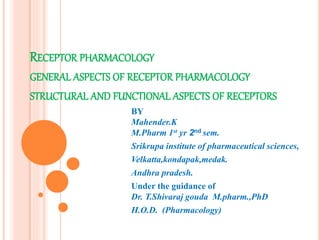

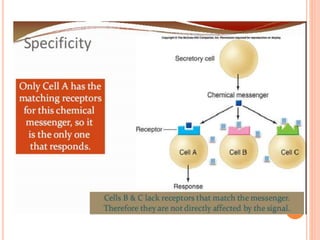
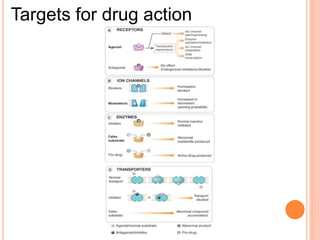

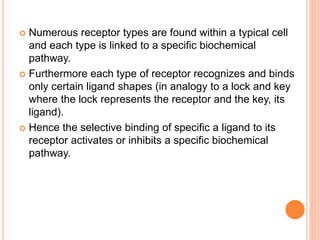
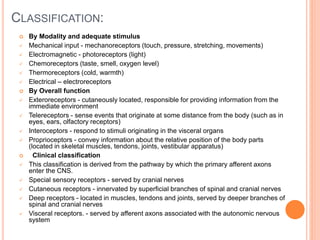
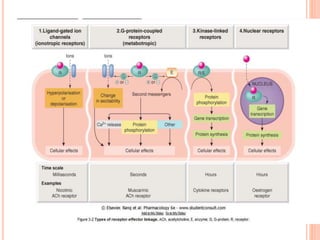
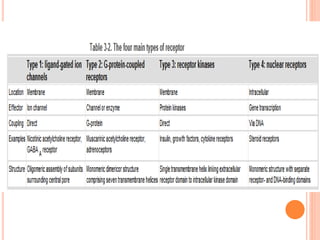
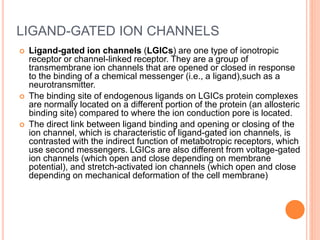
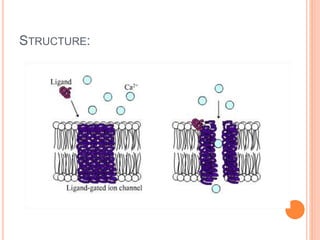
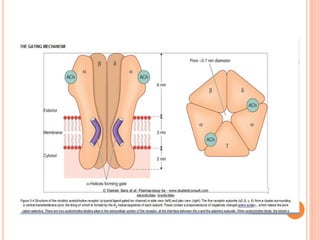


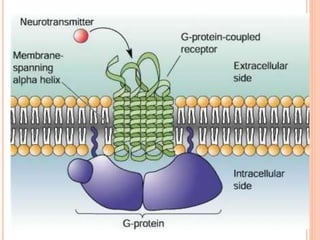
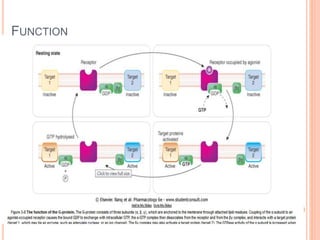
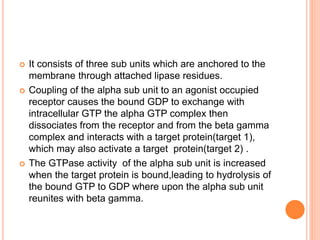

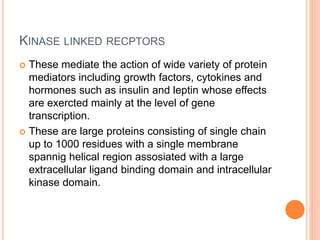
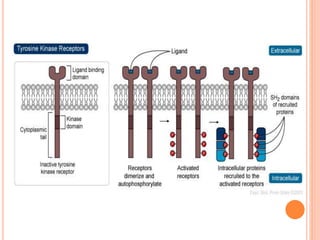

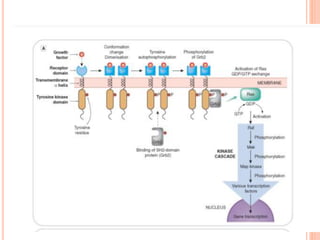
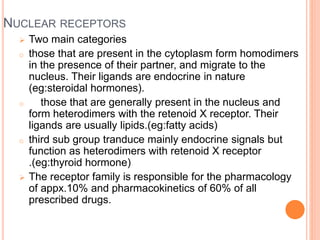
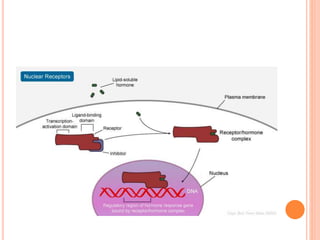

Ad
Recommended
Introduction to autonomic pharmacology
Introduction to autonomic pharmacologyUsmanKhalid135
Ėý
The document summarizes the structure and function of the nervous system. It describes how the nervous system is divided into the central nervous system (CNS) and peripheral nervous system. The peripheral nervous system is further divided into the efferent and afferent divisions. The efferent division carries signals from the CNS to peripheral tissues and is divided into the somatic and autonomic systems. The autonomic system regulates vital functions unconsciously through the neurotransmitters acetylcholine and norepinephrine. Acetylcholine and norepinephrine are synthesized, stored, released, and terminated through specific mechanisms to control organs and physiological processes.Non adrenergic, non-cholinergic (nanc) transmitters
Non adrenergic, non-cholinergic (nanc) transmittersRahulvaish13
Ėý
Non-adrenergic, non-cholinergic (NANC) neurotransmitters play important roles in synaptic transmission beyond acetylcholine and noradrenaline. NANC neurotransmitters include purines like ATP and adenosine, peptides, nitric oxide, and prostaglandins. These neurotransmitters are released from neurons and can regulate the release and effects of the primary neurotransmitters as well as have direct effects on their own. Common NANC transmitters in the autonomic nervous system include VIP, NPY, endothelins, CGRP, and ATP which have various effects on smooth muscle, blood vessels, and other tissues.Dr tarek NSAIDs
Dr tarek NSAIDsal azhar universty
Ėý
NSAIDs are a class of drugs that relieve pain, fever, and inflammation by inhibiting cyclooxygenase enzymes. There are various types of NSAIDs classified by their chemical structure. All NSAIDs work by blocking prostaglandin production, but they differ in their selectivity for COX-1 vs COX-2 enzymes. Common adverse effects include gastrointestinal irritation and bleeding, as well as renal impairment. NSAIDs are commonly used to treat pain, fever, and inflammatory conditions like arthritis.Alternatives to animal experiments
Alternatives to animal experimentsDr. Mohit Kulmi
Ėý
This document discusses alternatives to animal testing for drug development and safety testing. It outlines 4 steps to developing and validating alternative methods: defining the alternative, developing the alternative using in vitro and computer models, validating the methods, and gaining acceptance. Recent advances in stem cells and organ-on-chip models provide more human-relevant alternatives. In vitro tests using human cells, tissues, and organ models can replace animal use for toxicity, efficacy, and disease modeling. Computer models also simulate human biology for drug screening without animals.Local Anesthetics
Local Anesthetics Sujit Karpe
Ėý
Local anesthetics are drugs that cause reversible loss of sensation in a localized area of the body when applied to nerve tissues or mucous membranes. They work by reversibly blocking sodium ion channels, preventing the generation and conduction of nerve impulses. Common local anesthetics include lidocaine, bupivacaine, benzocaine, and procaine. They are classified based on their chemistry (ester or amide linkage) and duration of action. Local anesthetics can be administered via various techniques like infiltration, nerve block, spinal block, for procedures, surgeries and pain management in a localized region of the body.Pain pathway
Pain pathwayPGINeurosurgery
Ėý
The document provides an overview of pain pathways and mechanisms, categorizing pain into nociceptive, inflammatory, and neuropathic types. It describes the roles of various neurons and pathways in processing pain, including first, second, and third-order neurons, as well as different central structures involved in the pain matrix. Additionally, it addresses the clinical implications of these pathways and highlights craniofacial pain syndromes.Immunotherapeutics and Humanisation of antibodies
Immunotherapeutics and Humanisation of antibodiesSanju Kaladharan
Ėý
- Immunotherapeutics aim to activate the body's immune system to fight disease by triggering or mimicking immune responses. They include cytokines, monoclonal antibodies, antibody conjugates, and antibody-directed enzyme prodrug therapy.
- Monoclonal antibodies can directly induce cell death or block growth receptors. They also recruit immune cells through antibody-dependent cytotoxicity and complement-dependent cytotoxicity.
- Early monoclonal antibodies were murine but caused human anti-mouse antibody responses. Newer techniques generate chimeric antibodies by combining mouse and human portions or fully human antibodies from libraries or transgenic mice to reduce this immune response.Neurohumoral transmission in ans final fully1cl f
Neurohumoral transmission in ans final fully1cl frahulsharma3589
Ėý
1) Neurohumoral transmission involves the release of neurotransmitters from nerve terminals that activate specialized receptors on target cells, eliciting physiological responses.
2) Key events in neurohumoral transmission include axonal conduction, neurotransmitter release, receptor activation, post-junctional signal propagation, and neurotransmitter destruction.
3) The autonomic nervous system relies on neurohumoral transmission, using acetylcholine at parasympathetic nerve endings and norepinephrine at most sympathetic nerve endings.Pharmacogenomics
PharmacogenomicsANAND SAGAR TIWARI
Ėý
Pharmacogenomics is the study of how genetic factors affect individual responses to medications. The document discusses basic concepts like genes and alleles. It also covers the human genome project, genetic variation, gene mapping, cloning disease genes, and applications of various "omics" fields like pharmacogenomics. Pharmacogenomics aims to develop individualized drug treatments based on a person's genetic makeup.(Anti-fungal Drugs) pharmacology
(Anti-fungal Drugs) pharmacology AbhinayJha3
Ėý
This document summarizes antifungal drugs. It is divided into sections on classification, mechanism of action, antifungal spectrum, adverse effects, uses, and references. The main types of antifungals discussed are polyenes like amphotericin B, azoles like fluconazole and itraconazole, and echinocandins. Amphotericin B works by binding to ergosterol in the fungal cell membrane, forming pores that increase permeability. It has a broad spectrum but can cause acute reactions and nephrotoxicity. While effective for systemic mycoses, newer azoles are preferred due to lower toxicity.RECENT ADVANCES IN ALZHEIMER'S DISEASE
RECENT ADVANCES IN ALZHEIMER'S DISEASEsharad patange
Ėý
The document summarizes recent advances in understanding and treating Alzheimer's disease. It discusses both non-modifiable and modifiable risk factors for the disease. The major signs and symptoms include progressive memory loss and cognitive decline. Alzheimer's is confirmed through neuronal plaques and tangles seen in the brain. Recent treatment strategies aim to reduce amyloid plaques through vaccines, antibodies, and inhibitors of beta- and gamma-secretase. Other approaches include tau phosphorylation inhibitors, therapies for mitochondrial dysfunction, and cholinesterase inhibitors. Animal models continue to be important for studying the human APP, ApoE, and presenilin genes involved in Alzheimer's pathology.screening model for parkinsons disease
screening model for parkinsons diseaseKundlik Rathod
Ėý
This document discusses various screening models for Parkinson's disease, including pharmacological models using tremoring-inducing drugs and reserpine, toxin models using MPTP, 6-OHDA, rotenone, and paraquat, and genetic models using genes associated with Parkinson's like alpha-synuclein, LRRK2, parkin, and DJ-1. Alternative models discussed include Drosophila, C. elegans, zebrafish, and mouse models that aim to replicate features of Parkinson's like neurodegeneration of dopaminergic neurons and motor deficits. In summary, the document compares strengths and limitations of different Parkinson's disease models.Glutamate
Glutamateayanarkumar19
Ėý
Glutamate is the major excitatory neurotransmitter in the brain and is involved in cognitive functions like learning and memory. It has two major classes of receptors - ionotropic and metabotropic receptors. Glutamate is synthesized from glutamine via the glutamate-glutamine cycle and stored in vesicles for release. It is transported back into glial cells via glutamate transporters and converted back to glutamine. Drugs can target ionotropic receptors as antagonists to treat conditions caused by glutamate toxicity like neurodegeneration, ischemia and seizures.Anxiolytic screening models_utkarsh
Anxiolytic screening models_utkarshUtkarsh Alok
Ėý
This document summarizes screening methods for assessing anxiolytic activity. It describes several models used to test anxiety in rodents, including the light-dark test, elevated plus maze test, social interaction test, marble burying test, and Vogel conflict test. Each method exposes animals to an anxiety-provoking stimulus and measures behaviors like time spent in unprotected areas or number of marbles buried. Anxiolytic drugs are expected to reduce anxious behaviors in these tests. The document also provides details on procedures, parameters measured, and interpretation of results for each screening method.Tyrosine kinase receptors & Nuclear receptors
Tyrosine kinase receptors & Nuclear receptorsAaqib Naseer
Ėý
This document summarizes kinase receptors and nuclear receptors. Kinase receptors contain an extracellular ligand-binding domain connected by a transmembrane helix to an intracellular domain with kinase activity. They signal through phosphorylation cascades like MAPK. Nuclear receptors regulate gene transcription as ligand-activated transcription factors. They contain a ligand binding domain, DNA binding domain, and transcriptional regulation domain. Nuclear receptors form dimers and recruit cofactors to modify gene expression.Local anesthetics
Local anestheticsSubhash Yende
Ėý
Local anesthetics are drugs that cause reversible loss of sensation, especially pain, in a restricted area of the body when applied topically or injected locally. They block nerve impulse generation and conduction by stabilizing sodium channels in the inactive state. Common examples include lidocaine, bupivacaine, and procaine. Local anesthetics are used for surface anesthesia, infiltration anesthesia, nerve blocks, spinal anesthesia, and epidural anesthesia.Antisense oligonucleotide therapy
Antisense oligonucleotide therapypharmacologyseminars
Ėý
Antisense oligonucleotide therapy is a pharmacological approach that uses synthetic genetic material to inhibit protein translation by binding to mRNA. It works by blocking ribosomes, activating RNase enzymes, or forming triplex structures. Advantages include rapid manufacturing and potential for enhanced targeting. Limitations include short half-lives and difficulty directing to specific cells. Over 50 antisense compounds are in clinical trials for various diseases. The future of antisense-based therapies looks promising as more companies develop applications.Neurohumoral Transmission of Acetylcholine.pptx
Neurohumoral Transmission of Acetylcholine.pptxShraddhaRaut43
Ėý
The document discusses neurohumoral transmission in the autonomic nervous system, focusing primarily on acetylcholine as a key neurotransmitter for parasympathetic functions. It details the synthesis, storage, release, degradation, and reuptake processes of acetylcholine, as well as the types of cholinergic receptors that interact with it. Additionally, it addresses various toxins that can affect cholinergic transmission and references multiple pharmacology texts.Epilepsy recent advances and existing pharmacotherapy
Epilepsy recent advances and existing pharmacotherapyDr. Siddhartha Dutta
Ėý
The document provides a comprehensive overview of epilepsy, including its history, definitions, and the current state of therapy and drug targets. It discusses the need for new molecules due to issues like drug interactions and side effects, and presents various antiepileptic drugs, their mechanisms, and the latest advancements in treatment options. Additionally, newer therapies targeting sodium and calcium channels, as well as novel drug delivery systems, are explored in the context of improving patient outcomes.Receptors as Drug Targets
Receptors as Drug TargetsHtet Wai Moe
Ėý
This document discusses drug receptors and their role in mediating drug action. It describes the four main types of receptors: ligand-gated ion channels, G-protein coupled receptors, enzyme-linked receptors, and nuclear receptors. Ligand-gated ion channels directly open ion channels, while G-protein coupled receptors signal through G-proteins. Enzyme-linked receptors have intracellular enzyme domains, and nuclear receptors enter the nucleus to regulate gene transcription. Understanding receptors is important for rational drug design and determining mechanisms of drug action and selectivity.INHALATIONAL TOXICITY STUDIES.M pharmacy
INHALATIONAL TOXICITY STUDIES.M pharmacyAartiPal23
Ėý
The document presents guidelines for conducting inhalational toxicity studies, focusing on acute, subacute, and subchronic protocols as per OECD standards. Key aspects include methods for selecting animal species, exposure conditions, observation protocols, and data reporting requirements. The guidelines aim to provide data for risk assessments while minimizing animal usage and adapting to the evolving science of inhalation toxicology.Neurosteroids and neuropeptides
Neurosteroids and neuropeptidesJonaid Ali
Ėý
The document discusses neurosteroids and neuropeptides, highlighting their synthesis, classifications, mechanisms of action, and therapeutic applications. Neurosteroids, synthesized in the brain, can have either excitatory or inhibitory effects on neurotransmission, while neuropeptides serve as signaling molecules influencing various brain functions. Recent findings suggest both neurosteroids and neuropeptides are being explored for their clinical potential in treating central nervous system disorders.Screening methods for analgesics
Screening methods for analgesicsDr. Amit Sharma
Ėý
This document summarizes screening methods for central and peripheral analgesics. For central analgesics, it describes in vivo methods like Haffner's tail clip, hot plate, tail immersion, and formalin tests that assess response to painful stimuli in mice and rats. For peripheral analgesics, it discusses writhing tests using acetic acid or phenylquinone in mice, Randall-Selitto testing in inflamed rat paws, and duodenum distension in rats to measure visceral pain responses. The document provides classifications and examples of different classes of central and peripheral analgesic agents and their mechanisms of action.Screening methods for analgesics
Screening methods for analgesicsAmy Mehaboob
Ėý
The document outlines various screening methods for analgesics, which are drugs that alleviate pain. It details both in vitro assays like the 3H-naloxone binding assay and in vivo tests such as the Haffnerâs tail clip method and the hot plate method for evaluating analgesic effectiveness. Classification of analgesics includes various types such as narcotics, non-narcotics, and local anesthetics.Molecular and Cellular Mechanism of Action of Hormones such as Growth Hormone...
Molecular and Cellular Mechanism of Action of Hormones such as Growth Hormone...Ansari Aashif Raza Mohd Imtiyaz
Ėý
The document discusses the molecular and cellular mechanisms of hormones like growth hormone, prolactin, and insulin. It describes the roles of these hormones in growth, metabolism, and various medical applications, including replacement therapy and potential side effects. Additionally, it provides insights into hormone production, regulation, and methods of administration.ANS
ANSAshfaqur Rahman
Ėý
The autonomic nervous system (ANS) controls involuntary functions and has sympathetic and parasympathetic divisions. The sympathetic division prepares the body for emergencies via the "fight or flight" response while the parasympathetic division acts to conserve energy. The ANS has a two-neuron pathway from the CNS to effectors like glands and smooth muscle. It regulates functions like heart rate, digestion, and gland secretion to maintain homeostasis.Genetics variations in gpcr
Genetics variations in gpcrDeepak Kumar
Ėý
G-proteins are molecular switches that regulate various cellular activities. They exist in two classes: monomeric small GTPases and heterotrimeric complexes consisting of Îą, Îē, and Îģ subunits. G-protein coupled receptors (GPCRs) have seven transmembrane domains and interact with G-proteins via intracellular loops to transmit extracellular signals within the cell. Genetic variations in GPCRs can affect receptor functions like ligand binding and G-protein coupling, potentially causing diseases. Many single nucleotide polymorphisms and mutations have been linked to impaired or enhanced receptor signaling and diseases ranging from bleeding disorders to asthma, obesity, and immune deficiencies.Antisense oligonucleotide therapy
Antisense oligonucleotide therapyROHIT
Ėý
This document provides an overview of antisense oligonucleotide therapy, including its definition as synthetic genetic material that binds to mRNA to prevent protein translation, mechanisms of action such as blocking ribosomes and activating RNase enzymes, applications in oncology and other therapeutic areas, examples of compounds in clinical trials, and its future potential as over 30 compounds are currently in clinical trials.3. molecular mech of drug action presentn
3. molecular mech of drug action presentnsuniu
Ėý
The document discusses the molecular mechanisms of action of drugs. It describes four main ways drugs produce effects in the body: 1) by acting on receptors, 2) by inhibiting carriers, 3) by modulating or blocking ion channels, and 4) by inhibiting enzymes. It focuses on describing the different types of protein targets for drug action, including receptors, ion channels, enzymes, and carrier molecules. It provides details on the structure and function of receptors, the main types of receptor families, and concepts such as receptor heterogeneity, subtypes, and the actions of agonists and antagonists.Biological drug targets.pptx
Biological drug targets.pptxPurushothamKN1
Ėý
This document discusses biological drug targets and summarizes key points about receptors and drug-receptor interactions. It begins with an introduction to biological drug targets and explains that drugs produce their effects by binding to receptors and causing biochemical or physical changes. It then discusses the main types of receptors - ligand-gated ion channels, G-protein coupled receptors, kinase-linked receptors, and nuclear receptors. Theories of drug-receptor interaction are also summarized, including occupancy theory, rate theory, induced fit theory, and others. Finally, the document briefly introduces artificial enzymes as synthetic molecules that can mimic the functions of natural enzymes.More Related Content
What's hot (20)
Pharmacogenomics
PharmacogenomicsANAND SAGAR TIWARI
Ėý
Pharmacogenomics is the study of how genetic factors affect individual responses to medications. The document discusses basic concepts like genes and alleles. It also covers the human genome project, genetic variation, gene mapping, cloning disease genes, and applications of various "omics" fields like pharmacogenomics. Pharmacogenomics aims to develop individualized drug treatments based on a person's genetic makeup.(Anti-fungal Drugs) pharmacology
(Anti-fungal Drugs) pharmacology AbhinayJha3
Ėý
This document summarizes antifungal drugs. It is divided into sections on classification, mechanism of action, antifungal spectrum, adverse effects, uses, and references. The main types of antifungals discussed are polyenes like amphotericin B, azoles like fluconazole and itraconazole, and echinocandins. Amphotericin B works by binding to ergosterol in the fungal cell membrane, forming pores that increase permeability. It has a broad spectrum but can cause acute reactions and nephrotoxicity. While effective for systemic mycoses, newer azoles are preferred due to lower toxicity.RECENT ADVANCES IN ALZHEIMER'S DISEASE
RECENT ADVANCES IN ALZHEIMER'S DISEASEsharad patange
Ėý
The document summarizes recent advances in understanding and treating Alzheimer's disease. It discusses both non-modifiable and modifiable risk factors for the disease. The major signs and symptoms include progressive memory loss and cognitive decline. Alzheimer's is confirmed through neuronal plaques and tangles seen in the brain. Recent treatment strategies aim to reduce amyloid plaques through vaccines, antibodies, and inhibitors of beta- and gamma-secretase. Other approaches include tau phosphorylation inhibitors, therapies for mitochondrial dysfunction, and cholinesterase inhibitors. Animal models continue to be important for studying the human APP, ApoE, and presenilin genes involved in Alzheimer's pathology.screening model for parkinsons disease
screening model for parkinsons diseaseKundlik Rathod
Ėý
This document discusses various screening models for Parkinson's disease, including pharmacological models using tremoring-inducing drugs and reserpine, toxin models using MPTP, 6-OHDA, rotenone, and paraquat, and genetic models using genes associated with Parkinson's like alpha-synuclein, LRRK2, parkin, and DJ-1. Alternative models discussed include Drosophila, C. elegans, zebrafish, and mouse models that aim to replicate features of Parkinson's like neurodegeneration of dopaminergic neurons and motor deficits. In summary, the document compares strengths and limitations of different Parkinson's disease models.Glutamate
Glutamateayanarkumar19
Ėý
Glutamate is the major excitatory neurotransmitter in the brain and is involved in cognitive functions like learning and memory. It has two major classes of receptors - ionotropic and metabotropic receptors. Glutamate is synthesized from glutamine via the glutamate-glutamine cycle and stored in vesicles for release. It is transported back into glial cells via glutamate transporters and converted back to glutamine. Drugs can target ionotropic receptors as antagonists to treat conditions caused by glutamate toxicity like neurodegeneration, ischemia and seizures.Anxiolytic screening models_utkarsh
Anxiolytic screening models_utkarshUtkarsh Alok
Ėý
This document summarizes screening methods for assessing anxiolytic activity. It describes several models used to test anxiety in rodents, including the light-dark test, elevated plus maze test, social interaction test, marble burying test, and Vogel conflict test. Each method exposes animals to an anxiety-provoking stimulus and measures behaviors like time spent in unprotected areas or number of marbles buried. Anxiolytic drugs are expected to reduce anxious behaviors in these tests. The document also provides details on procedures, parameters measured, and interpretation of results for each screening method.Tyrosine kinase receptors & Nuclear receptors
Tyrosine kinase receptors & Nuclear receptorsAaqib Naseer
Ėý
This document summarizes kinase receptors and nuclear receptors. Kinase receptors contain an extracellular ligand-binding domain connected by a transmembrane helix to an intracellular domain with kinase activity. They signal through phosphorylation cascades like MAPK. Nuclear receptors regulate gene transcription as ligand-activated transcription factors. They contain a ligand binding domain, DNA binding domain, and transcriptional regulation domain. Nuclear receptors form dimers and recruit cofactors to modify gene expression.Local anesthetics
Local anestheticsSubhash Yende
Ėý
Local anesthetics are drugs that cause reversible loss of sensation, especially pain, in a restricted area of the body when applied topically or injected locally. They block nerve impulse generation and conduction by stabilizing sodium channels in the inactive state. Common examples include lidocaine, bupivacaine, and procaine. Local anesthetics are used for surface anesthesia, infiltration anesthesia, nerve blocks, spinal anesthesia, and epidural anesthesia.Antisense oligonucleotide therapy
Antisense oligonucleotide therapypharmacologyseminars
Ėý
Antisense oligonucleotide therapy is a pharmacological approach that uses synthetic genetic material to inhibit protein translation by binding to mRNA. It works by blocking ribosomes, activating RNase enzymes, or forming triplex structures. Advantages include rapid manufacturing and potential for enhanced targeting. Limitations include short half-lives and difficulty directing to specific cells. Over 50 antisense compounds are in clinical trials for various diseases. The future of antisense-based therapies looks promising as more companies develop applications.Neurohumoral Transmission of Acetylcholine.pptx
Neurohumoral Transmission of Acetylcholine.pptxShraddhaRaut43
Ėý
The document discusses neurohumoral transmission in the autonomic nervous system, focusing primarily on acetylcholine as a key neurotransmitter for parasympathetic functions. It details the synthesis, storage, release, degradation, and reuptake processes of acetylcholine, as well as the types of cholinergic receptors that interact with it. Additionally, it addresses various toxins that can affect cholinergic transmission and references multiple pharmacology texts.Epilepsy recent advances and existing pharmacotherapy
Epilepsy recent advances and existing pharmacotherapyDr. Siddhartha Dutta
Ėý
The document provides a comprehensive overview of epilepsy, including its history, definitions, and the current state of therapy and drug targets. It discusses the need for new molecules due to issues like drug interactions and side effects, and presents various antiepileptic drugs, their mechanisms, and the latest advancements in treatment options. Additionally, newer therapies targeting sodium and calcium channels, as well as novel drug delivery systems, are explored in the context of improving patient outcomes.Receptors as Drug Targets
Receptors as Drug TargetsHtet Wai Moe
Ėý
This document discusses drug receptors and their role in mediating drug action. It describes the four main types of receptors: ligand-gated ion channels, G-protein coupled receptors, enzyme-linked receptors, and nuclear receptors. Ligand-gated ion channels directly open ion channels, while G-protein coupled receptors signal through G-proteins. Enzyme-linked receptors have intracellular enzyme domains, and nuclear receptors enter the nucleus to regulate gene transcription. Understanding receptors is important for rational drug design and determining mechanisms of drug action and selectivity.INHALATIONAL TOXICITY STUDIES.M pharmacy
INHALATIONAL TOXICITY STUDIES.M pharmacyAartiPal23
Ėý
The document presents guidelines for conducting inhalational toxicity studies, focusing on acute, subacute, and subchronic protocols as per OECD standards. Key aspects include methods for selecting animal species, exposure conditions, observation protocols, and data reporting requirements. The guidelines aim to provide data for risk assessments while minimizing animal usage and adapting to the evolving science of inhalation toxicology.Neurosteroids and neuropeptides
Neurosteroids and neuropeptidesJonaid Ali
Ėý
The document discusses neurosteroids and neuropeptides, highlighting their synthesis, classifications, mechanisms of action, and therapeutic applications. Neurosteroids, synthesized in the brain, can have either excitatory or inhibitory effects on neurotransmission, while neuropeptides serve as signaling molecules influencing various brain functions. Recent findings suggest both neurosteroids and neuropeptides are being explored for their clinical potential in treating central nervous system disorders.Screening methods for analgesics
Screening methods for analgesicsDr. Amit Sharma
Ėý
This document summarizes screening methods for central and peripheral analgesics. For central analgesics, it describes in vivo methods like Haffner's tail clip, hot plate, tail immersion, and formalin tests that assess response to painful stimuli in mice and rats. For peripheral analgesics, it discusses writhing tests using acetic acid or phenylquinone in mice, Randall-Selitto testing in inflamed rat paws, and duodenum distension in rats to measure visceral pain responses. The document provides classifications and examples of different classes of central and peripheral analgesic agents and their mechanisms of action.Screening methods for analgesics
Screening methods for analgesicsAmy Mehaboob
Ėý
The document outlines various screening methods for analgesics, which are drugs that alleviate pain. It details both in vitro assays like the 3H-naloxone binding assay and in vivo tests such as the Haffnerâs tail clip method and the hot plate method for evaluating analgesic effectiveness. Classification of analgesics includes various types such as narcotics, non-narcotics, and local anesthetics.Molecular and Cellular Mechanism of Action of Hormones such as Growth Hormone...
Molecular and Cellular Mechanism of Action of Hormones such as Growth Hormone...Ansari Aashif Raza Mohd Imtiyaz
Ėý
The document discusses the molecular and cellular mechanisms of hormones like growth hormone, prolactin, and insulin. It describes the roles of these hormones in growth, metabolism, and various medical applications, including replacement therapy and potential side effects. Additionally, it provides insights into hormone production, regulation, and methods of administration.ANS
ANSAshfaqur Rahman
Ėý
The autonomic nervous system (ANS) controls involuntary functions and has sympathetic and parasympathetic divisions. The sympathetic division prepares the body for emergencies via the "fight or flight" response while the parasympathetic division acts to conserve energy. The ANS has a two-neuron pathway from the CNS to effectors like glands and smooth muscle. It regulates functions like heart rate, digestion, and gland secretion to maintain homeostasis.Genetics variations in gpcr
Genetics variations in gpcrDeepak Kumar
Ėý
G-proteins are molecular switches that regulate various cellular activities. They exist in two classes: monomeric small GTPases and heterotrimeric complexes consisting of Îą, Îē, and Îģ subunits. G-protein coupled receptors (GPCRs) have seven transmembrane domains and interact with G-proteins via intracellular loops to transmit extracellular signals within the cell. Genetic variations in GPCRs can affect receptor functions like ligand binding and G-protein coupling, potentially causing diseases. Many single nucleotide polymorphisms and mutations have been linked to impaired or enhanced receptor signaling and diseases ranging from bleeding disorders to asthma, obesity, and immune deficiencies.Antisense oligonucleotide therapy
Antisense oligonucleotide therapyROHIT
Ėý
This document provides an overview of antisense oligonucleotide therapy, including its definition as synthetic genetic material that binds to mRNA to prevent protein translation, mechanisms of action such as blocking ribosomes and activating RNase enzymes, applications in oncology and other therapeutic areas, examples of compounds in clinical trials, and its future potential as over 30 compounds are currently in clinical trials.Molecular and Cellular Mechanism of Action of Hormones such as Growth Hormone...
Molecular and Cellular Mechanism of Action of Hormones such as Growth Hormone...Ansari Aashif Raza Mohd Imtiyaz
Ėý
Similar to Mine ap (20)
3. molecular mech of drug action presentn
3. molecular mech of drug action presentnsuniu
Ėý
The document discusses the molecular mechanisms of action of drugs. It describes four main ways drugs produce effects in the body: 1) by acting on receptors, 2) by inhibiting carriers, 3) by modulating or blocking ion channels, and 4) by inhibiting enzymes. It focuses on describing the different types of protein targets for drug action, including receptors, ion channels, enzymes, and carrier molecules. It provides details on the structure and function of receptors, the main types of receptor families, and concepts such as receptor heterogeneity, subtypes, and the actions of agonists and antagonists.Biological drug targets.pptx
Biological drug targets.pptxPurushothamKN1
Ėý
This document discusses biological drug targets and summarizes key points about receptors and drug-receptor interactions. It begins with an introduction to biological drug targets and explains that drugs produce their effects by binding to receptors and causing biochemical or physical changes. It then discusses the main types of receptors - ligand-gated ion channels, G-protein coupled receptors, kinase-linked receptors, and nuclear receptors. Theories of drug-receptor interaction are also summarized, including occupancy theory, rate theory, induced fit theory, and others. Finally, the document briefly introduces artificial enzymes as synthetic molecules that can mimic the functions of natural enzymes.Receptor basics
Receptor basicsFoziyaKhan
Ėý
Receptors are proteins that receive chemical signals from outside the cell. When a ligand binds to a receptor, it causes a cellular response. There are several types of receptors including ion channel linked receptors, G-protein linked receptors, enzyme linked receptors, and nuclear receptors. Nuclear receptors are located within cells and bind lipophilic ligands like steroids and lipids to regulate gene expression. [/SUMMARY]Receptors
ReceptorsNITESH KUMAR
Ėý
The document explains the definition and types of receptors in pharmacology, highlighting how they interact with drugs to elicit responses. It details four main receptors: ligand-gated ion channels, G-protein coupled receptors, kinase-linked receptors, and nuclear receptors, including their structure and function. Each type of receptor has specific mechanisms for signal transduction and pharmacological effects, illustrating the complex interactions between drugs and biological systems.Receptors 1
Receptors 1Sayeed Samrul
Ėý
This document provides information about a receptor pharmacology course taught by Professor Dr. Md. Shah Amran at the University of Dhaka. It was prepared by 5 students and contains an introduction to receptors, classifications of different receptor types including ligand gated ion channels, G-protein coupled receptors, enzyme linked receptors, and nuclear receptors. It also discusses receptor-drug interactions, affinity, intrinsic activity, and mechanisms of cell surface and intracellular receptors.Receptors-1
Receptors-1Samrul Islam
Ėý
This document provides information about a receptor pharmacology course taught by Professor Dr. Md. Shah Amran at the University of Dhaka. It was prepared by 5 students and contains contents on different types of receptors including ligand gated ion channels, G-protein coupled receptors, enzyme linked receptors, nuclear receptors, and a comparison of receptor types. Receptors are important macromolecules that bind drugs and mediate their effects in the body.receptors.pptx and its types and mechanism
receptors.pptx and its types and mechanismGuttiKrishnasriRolln
Ėý
Different receptor types and structure of them Receptors seminar.pptx
Receptors seminar.pptxRashuRaju
Ėý
The document provides an overview of receptors, including their definitions, classifications, and mechanisms of action. It details three main types of receptors: intracellular, cell-surface, and nuclear receptors, along with their structural components and the forces affecting drug-receptor binding. The document also describes the roles of agonists and antagonists in pharmacology.Pharmacology Unit - 2.pptx
Pharmacology Unit - 2.pptxNikita Gupta
Ėý
This document discusses pharmacodynamics and the mechanisms of drug action. It explains that pharmacodynamics is the study of how drugs act on the body and their effects, focusing on drug-receptor interactions and the biochemical and physiological impacts of drugs. Various mechanisms are described, including stimulation, depression, irritation, and replacement effects. The key mechanisms of drug action are interactions with receptors, ion channels, enzymes, and transporter proteins. Different types of receptors - ligand-gated ion channels, G-protein coupled receptors, kinase-linked receptors, and nuclear receptors - are also outlined.Unit 2 General Pharmacology (As per PCI syllabus)
Unit 2 General Pharmacology (As per PCI syllabus)Mirza Anwar Baig
Ėý
This document provides an overview of drug pharmacology and mechanisms of action. It discusses:
1) Drugs act by interacting with receptors on cells and initiating signal transduction pathways. This allows small drug signals to be amplified within cells.
2) There are four main families of receptors: ligand-gated ion channels, G protein-coupled receptors, enzyme-linked receptors, and intracellular receptors.
3) Drug effects depend on their intrinsic activity as full agonists, partial agonists, inverse agonists or antagonists. Antagonists can be competitive, irreversible or allosteric. General physiology of receptor
General physiology of receptorsunil rapolu
Ėý
Receptors are proteins located on cells that bind to specific ligands, undergo a conformational change, and initiate a cellular response. There are two main types of receptors: ionotropic receptors which function as ion channels, and metabotropic receptors which activate intracellular signaling pathways. Ligands that activate receptors are classified as agonists, partial agonists, inverse agonists, or antagonists depending on their efficacy. Receptors are also classified based on their location, such as sensory nerve endings which detect stimuli inside and outside the body.Role of receptors in drug design
Role of receptors in drug designRoshni Ann
Ėý
This document provides an overview of receptors in drug design. It begins by discussing the historical concept of receptors proposed by Langley and Ehrlich. Key terms like ligand, affinity, intrinsic activity, and signal transduction are introduced. The molecular biology of receptors is explained, including their structure as membrane proteins with binding sites, and mechanisms of signal transduction like controlling ion channels or activating signal proteins. Different types of receptor-ligand interactions are covered, such as those between agonists, antagonists, irreversible antagonists, and allosteric modulators. Finally, major receptor theories including Clark's occupancy theory, two-state model, and rate theory are summarized.Receptors Types and details
Receptors Types and detailsShilpa Harak
Ėý
Receptors are globular proteins located in the cell membrane that receive messages from chemical messengers. When a messenger binds to a receptor's binding site, it causes a conformational change in the receptor through induced fit. This change initiates a signal transduction cascade inside the cell, leading to a cellular response without the messenger entering the cell. The main types of receptors are ion channel receptors, G-protein coupled receptors, kinase-linked receptors, and intracellular receptors. Each triggers distinct downstream signaling pathways through opening ion channels, activating G-proteins, phosphorylating proteins, or regulating gene expression respectively.The Mechanisms of Drug Actions in Pharmacology
The Mechanisms of Drug Actions in Pharmacologysedataltugtr
Ėý
The document discusses pharmacodynamics, focusing on drug actions and their interaction with receptors in the body, which initiate cellular responses through mechanisms such as signal transduction. It explains different types of receptors, how they operate, and differentiates between various receptor families, including ligand-gated ion channels and G proteinâcoupled receptors. Additionally, the document addresses concepts like desensitization and the impact of agonists and antagonists on receptor functionality.Receptor
ReceptorStanley Palma
Ėý
The document discusses the role of receptors in biochemistry and pharmacology, highlighting their function in receiving chemical signals from outside cells, leading to cellular responses. It categorizes receptors into internal and cell-surface types, detailing their mechanisms and interactions with chemical messengers like neurotransmitters and hormones. The document also distinguishes between agonists and antagonists, explaining their effects on receptor activation and drug design considerations.Receptor pharmacology Uttam & Renoo
Receptor pharmacology Uttam & Renoouttam singh
Ėý
Receptors are binding sites located on cells that bind specific molecules and initiate responses. There are several types of receptors including ionotropic receptors that act as ligand-gated ion channels, G protein-coupled receptors that activate intracellular signaling pathways via G proteins, and intracellular or nuclear receptors that directly influence gene expression. Receptor binding involves various interaction forces and leads to responses by altering cellular functions. Understanding receptor pharmacology is crucial for explaining how drugs produce their effects.Drug receptors in pharmacology
Drug receptors in pharmacologyBindu Pulugurtha
Ėý
The document summarizes different types of receptors and their classification. It discusses four main types of receptors: ligand gated ion channel receptors (inotropic), G-protein coupled receptors (metabotropic), kinase linked receptors, and nuclear receptors. It provides details about their molecular structure, signaling mechanisms, examples, and comparisons between receptor types. In summary, the document provides an overview of receptor pharmacology, classification of receptors, and their role in drug action and signaling pathways.Physiological receptors
Physiological receptorsSantosh Mogali
Ėý
This document discusses the pharmacology of receptors, including the main types of receptors, how they function through secondary messengers, and how they can be regulated. It covers ligand-gated ion channels, G protein-coupled receptors, and transcription factors. Receptor regulation and drug-receptor interactions are also explained. The document notes how receptor malfunctions can cause diseases and the significance of receptor subtypes for developing subtype-selective drugs.Receptor
ReceptorJai Narain Vyas University Jodhpur Rajasthan India 342003
Ėý
The document discusses the role of receptors as protein molecules that bind ligands to transmit signals in the body, detailing types of receptors such as ligand-gated ion channels, G protein-coupled receptors, and receptor tyrosine kinases. It explains the difference between agonists and antagonists based on their binding efficacy and impact on physiological responses. The document further emphasizes the significance of receptors in drug targeting and various biological processes.Receptor seminar by Dr.Mahi Yeruva
Receptor seminar by Dr.Mahi YeruvaMahi Yeruva
Ėý
Receptors are macromolecular components of cells that interact with drugs and initiate biochemical events leading to the drug's effects. The main types are ligand-gated ion channels, G protein-coupled receptors, kinase-linked receptors, and nuclear receptors. Ligand-gated ion channels allow ion flow in response to ligand binding. G protein-coupled receptors signal via intracellular G proteins and second messengers. Kinase-linked receptors activate intracellular kinase cascades. Nuclear receptors regulate gene transcription as ligand-activated transcription factors in the nucleus. Together these receptor types mediate diverse drug actions in important physiological systems.Ad
More from mahender Kotte (7)
My ppt.
My ppt.mahender Kotte
Ėý
The document outlines the general process for preclinical drug development, including the goals of preclinical studies to determine a product's safety profile and limit risks to human subjects. It describes how flowcharts are used to logically assess risks and guide decision making around transitioning from preclinical to clinical trials. The key areas of preclinical investigation are mentioned, along with the importance of clinical observations and signs of toxicity in interpreting safety data from minimal acute toxicity tests in animals.My ppt
My pptmahender Kotte
Ėý
This document discusses free radicals, antioxidants, allergy, immunomodulation, and inflammation. It defines free radicals as atoms or groups of atoms with an odd number of electrons that can cause damage in the body. Antioxidants help terminate free radical chain reactions to prevent damage. Allergies occur when the immune system reacts to normally harmless substances. Immunomodulators help regulate the immune system by normalizing its response. Inflammation is the body's protective response to harmful stimuli, involving chemical mediators and cellular components. Various disorders are associated with abnormal inflammation and immune responses.Patch clamp technique
Patch clamp techniquemahender Kotte
Ėý
The patch clamp technique allows study of single or multiple ion channels in cells. It involves forming a high resistance seal between a glass micropipette and the cell membrane. There are several variations of the technique depending on the configuration of the pipette and cell membrane, including cell-attached, inside-out, whole-cell, and outside-out patches. Erwin Neher and Bert Sakmann developed the patch clamp technique in the 1970s-1980s and won the Nobel Prize for proving ion channels' involvement in cell processes using this method.Mahi ddmp
Mahi ddmpmahender Kotte
Ėý
This document summarizes several herbal drugs that have anti-hyperlipidemic properties. It discusses artichoke, prosopis cineraria bark, and fenugreek. Artichoke contains sesquiterpenes and sesquiterpene glycosides that were found to suppress serum triglyceride elevation and inhibit gastric emptying, contributing to its anti-hyperlipidemic effects. Prosopis cineraria bark contains bioactive compounds and was shown to lower blood glucose and maintain lipid profile parameters in diabetic mice. Fenugreek contains fiber, saponins, and protein that are believed to contribute to its ability to significantly reduce total cholesterol, triglycerides, and LDL cholesterol in hyperlipMine...
Mine...mahender Kotte
Ėý
Clinical trials are designed to test the safety and efficacy of new drugs or medical devices on humans. They typically progress through four phases, beginning with small healthy volunteer studies (Phase I) to test safety, followed by larger patient studies (Phase II and III) to further evaluate safety and effectiveness. Phase IV trials monitor drugs after marketing approval to detect rare or long-term adverse effects. Rigorous design, oversight, and reporting are needed to minimize risks while maximizing benefits from clinical research.molecular biology techniques
molecular biology techniquesmahender Kotte
Ėý
This document provides an overview of molecular biology techniques. It discusses the fields of molecular biology, biochemistry, and genetics. It then describes several key techniques used in molecular biology, including expression cloning, polymerase chain reaction (PCR), gel electrophoresis, Southern blotting, Northern blotting, Western blotting, arrays, and allele specific oligonucleotides. It notes that older techniques like viscometry and sucrose gradient sedimentation have been replaced by newer methods like gel electrophoresis and PCR.IPR NDA and ANDA
IPR NDA and ANDAmahender Kotte
Ėý
An abbreviated new drug application (ANDA) is submitted to the FDA to obtain approval for a generic drug version of an already approved brand name drug. The ANDA process allows for generic drugs to be approved without repeating clinical trials, as long as the generic drug is proven to be bioequivalent to the original drug. If approved, a generic drug application allows the applicant to manufacture and market a safe, effective and lower-cost alternative to the original brand name drug. The ANDA review process focuses on demonstrating bioequivalence rather than requiring new clinical trial data.Ad
Mine ap
- 1. RECEPTOR PHARMACOLOGY GENERAL ASPECTS OF RECEPTOR PHARMACOLOGY STRUCTURAL AND FUNCTIONAL ASPECTS OF RECEPTORS BY Mahender.K M.Pharm 1st yr 2nd sem. Srikrupa institute of pharmaceutical sciences, Velkatta,kondapak,medak. Andhra pradesh. Under the guidance of Dr. T.Shivaraj gouda M.pharm.,PhD H.O.D. (Pharmacology)
- 2. RECEPTOR ïĒ A receptor is a molecule most often found on the surface of a cell, which receives chemical signals originating externally from the cell. ïĒ Through binding to a receptor, these signals direct a cell to do somethingâfor example to divide or die, or to allow certain molecules to enter or exit.
- 4. Targets for drug action
- 5. ïĒ Receptors are protein molecules, embedded in either the plasma membrane (cell surface receptors) or the cytoplasm or nucleus (nuclear receptors) of a cell, to which one or more specific kinds of signaling molecules may attach. ïĒ A molecule which binds (attaches) to a receptor is called a ligand, and may be a peptide (short protein) or other small molecule, such as a neurotransmitter, a hormone, a pharmaceutical drug, or a toxin.
- 6. ïĒ Numerous receptor types are found within a typical cell and each type is linked to a specific biochemical pathway. ïĒ Furthermore each type of receptor recognizes and binds only certain ligand shapes (in analogy to a lock and key where the lock represents the receptor and the key, its ligand). ïĒ Hence the selective binding of specific a ligand to its receptor activates or inhibits a specific biochemical pathway.
- 7. CLASSIFICATION: ïĒ By Modality and adequate stimulus ïž Mechanical input - mechanoreceptors (touch, pressure, stretching, movements) ïž Electromagnetic - photoreceptors (light) ïž Chemoreceptors (taste, smell, oxygen level) ïž Thermoreceptors (cold, warmth) ïž Electrical â electroreceptors ïĒ By Overall function ïž Exteroreceptors - cutaneously located, responsible for providing information from the immediate environment ïž Telereceptors - sense events that originate at some distance from the body (such as in eyes, ears, olfactory receptors) ïž Interoceptors - respond to stimuli originating in the visceral organs ïž Proprioceptors - convey information about the relative position of the body parts (located in skeletal muscles, tendons, joints, vestibular apparatus) ïĒ Clinical classification ïž This classification is derived from the pathway by which the primary afferent axons enter the CNS. ïž Special sensory receptors - served by cranial nerves ïž Cutaneous receptors - innervated by superficial branches of spinal and cranial nerves ïž Deep receptors - located in muscles, tendons and joints, served by deeper branches of spinal and cranial nerves ïž Visceral receptors. - served by afferent axons associated with the autonomic nervous system
- 10. LIGAND-GATED ION CHANNELS ïĒ Ligand-gated ion channels (LGICs) are one type of ionotropic receptor or channel-linked receptor. They are a group of transmembrane ion channels that are opened or closed in response to the binding of a chemical messenger (i.e., a ligand),such as a neurotransmitter. ïĒ The binding site of endogenous ligands on LGICs protein complexes are normally located on a different portion of the protein (an allosteric binding site) compared to where the ion conduction pore is located. ïĒ The direct link between ligand binding and opening or closing of the ion channel, which is characteristic of ligand-gated ion channels, is contrasted with the indirect function of metabotropic receptors, which use second messengers. LGICs are also different from voltage-gated ion channels (which open and close depending on membrane potential), and stretch-activated ion channels (which open and close depending on mechanical deformation of the cell membrane)
- 11. STRUCTURE:
- 13. ïĒ The five receptor sub units (2Îą,Îē,Îģ,Îī) form a cluster surrounding a central transmembrane pore, the lining is formed by M2 hellical segment of each subunit. ïĒ These contains a preponderance of negatively charged amino acids , which makes the pore cation selective. ïĒ There are two Ach binding sites in the extracellular portion of the receptor, at the interface between the alpha and the adjoining sub units. ïĒ When two Ach binds the Îą helices swing out of the way thus opening the channel pore.
- 14. G PROTEIN-COUPLED RECEPTOR ïĒ It consists of a single polypeptide chain of up to 1100 residues. ïĒ Their characteristic structure consists of 7 trans membrane alpha helicessimilar to those of ion channels, with an extracellular N terminal domain of varying length and intracellular C terminal domain.
- 16. FUNCTION
- 17. ïĒ It consists of three sub units which are anchored to the membrane through attached lipase residues. ïĒ Coupling of the alpha sub unit to an agonist occupied receptor causes the bound GDP to exchange with intracellular GTP the alpha GTP complex then dissociates from the receptor and from the beta gamma complex and interacts with a target protein(target 1), which may also activate a target protein(target 2) . ïĒ The GTPase activity of the alpha sub unit is increased when the target protein is bound,leading to hydrolysis of the bound GTP to GDP where upon the alpha sub unit reunites with beta gamma.
- 19. KINASE LINKED RECPTORS ïĒ These mediate the action of wide variety of protein mediators including growth factors, cytokines and hormones such as insulin and leptin whose effects are exercted mainly at the level of gene transcription. ïĒ These are large proteins consisting of single chain up to 1000 residues with a single membrane spannig helical region assosiated with a large extracellular ligand binding domain and intracellular kinase domain.
- 21. ïĒ Receptors of various growth factors incorporate tyrosine kinase in their intracellular domain. ïĒ Cytokine receptors have an intracellular domain that binds and activates cytosolic kinase when the receptor is occupied. ïĒ Signal transduction generally involves dimerisation of receptors, followed by autophosporylation of tyrosine residues. The posphotyrosine residues acts as acceptors for SH2domains of intra cellular proteins,there by allowing control of many cell functions,
- 23. NUCLEAR RECEPTORS ï Two main categories o those that are present in the cytoplasm form homodimers in the presence of their partner, and migrate to the nucleus. Their ligands are endocrine in nature (eg:steroidal hormones). o those that are generally present in the nucleus and form heterodimers with the retenoid X receptor. Their ligands are usually lipids.(eg:fatty acids) o third sub group tranduce mainly endocrine signals but function as heterodimers with retenoid X receptor .(eg:thyroid hormone) ï The receptor family is responsible for the pharmacology of appx.10% and pharmacokinetics of 60% of all prescribed drugs.
- 25. THANK YOU
